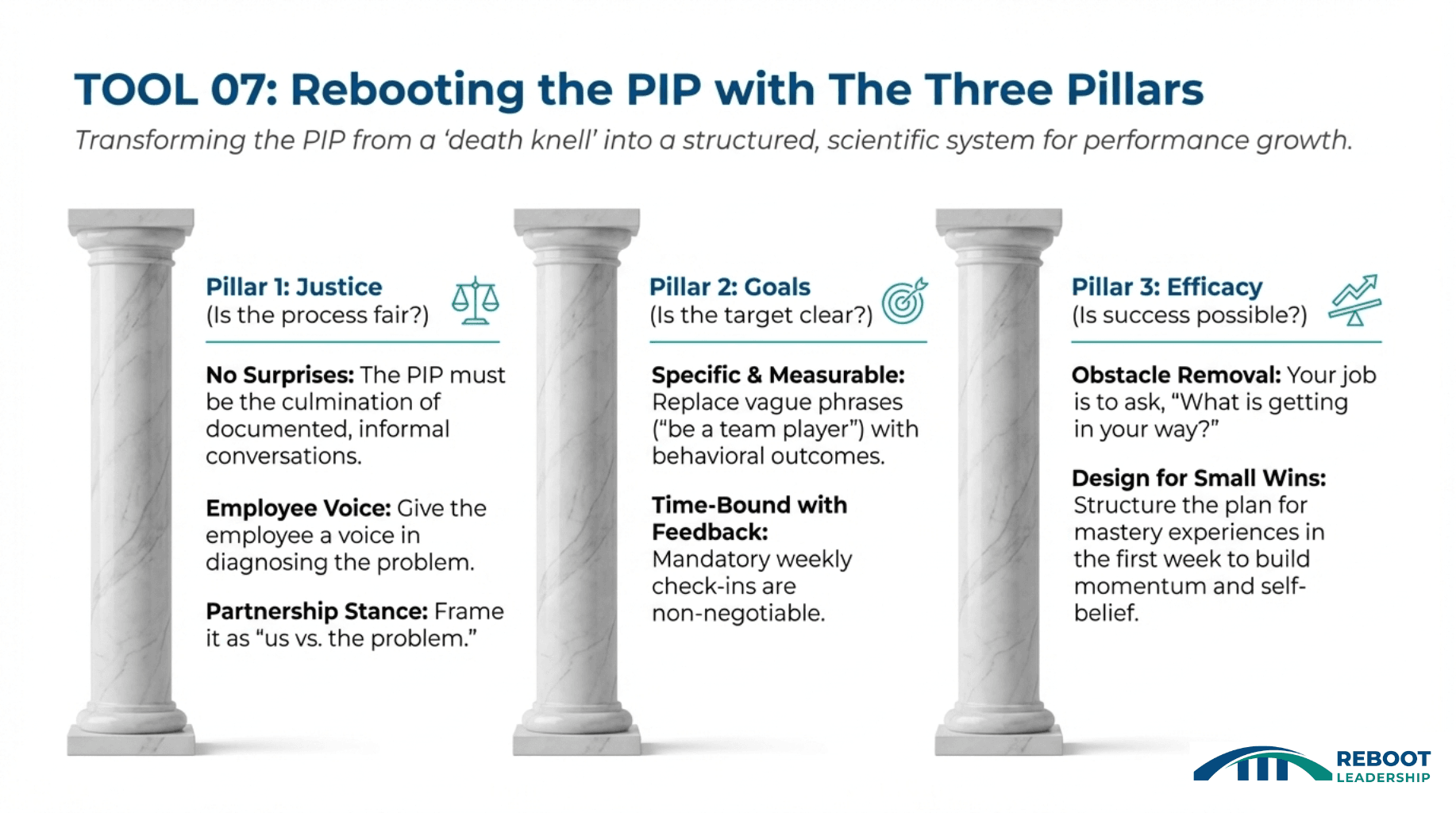For many leaders, the simple phrase “holding someone accountable” creates a knot in their stomach. We dread it, seeing it as the opposite of empathy.
This is a common cycle I call the “Reformer’s Trap.” It’s what happens when leaders, often with the best of intentions, default to judgment at the expense of trust.
(If you’ve been on the receiving end of that judgment instead of delivering it, you might prefer my article on Receiving Feedback: An Essential Checklist for Leaders.)
This punitive, control-based mindset creates fear, not growth. And its ultimate, most broken tool is a formal process that, for many, has become a dreaded phrase: the “Performance Improvement Plan,” or PIP.
For employees, hearing “You’re on a PIP” can feel like a death knell, the new “Final Written Warning.” For many managers, it’s just an administrative hurdle imposed by HR to ensure legal coverage before firing someone.
This entire framing is broken. A formal process shouldn’t be a countdown to termination; it should be a structured, compassionate “re-commitment” to that employee’s success.
This grim reputation isn’t because the idea of a PIP is inherently flawed. It’s the way it’s been used—as the final symptom of the Reformer’s Trap.
The Problem with “Last Resort” Thinking
The core problem with last-resort PIPs is that they come too late in the game, too long after 1:1 meetings and feedback sessions haven’t created change.
When PIPs are used only after a performance problem has spiraled, they’re seen as punishment, not opportunity. And employees become defensive, demoralized, or disengaged, because there’s no real path to success for them. This “check-the-box” mindset erodes trust and destroys any remaining motivation. Worse, it signals to other team members that performance issues are handled with bureaucracy and fear, not support or fairness.
But the problem is even deeper. The typical PIP process fails because it is motivationally bankrupt. It violates the core, proven principles of what actually helps people change and improve.
If you want to “reboot” your PIPs, you don’t need a new acronym. You need a new engine. You need a new process built on three pillars of proven psychological science: Justice, Goals, and Efficacy.

Pillar 1: The Justice Pillar (Is the process fair?)
The primary failure of a PIP is that it feels unjust. In organizational science, Procedural Justice is the perceived fairness of a process, and Interactional Justice is the sense of being treated with dignity and respect. A “death knell” PIP fails both tests; the outcome feels pre-determined, and the delivery feels cold.
To reboot the PIP, you must build visible fairness into every step:
- No Surprises: A PIP should never be a shock. It must be the formal culmination of multiple, documented, informal feedback conversations. If the employee is surprised, you failed as a manager before the PIP even began.
- Employee Voice: Do not deliver a list of commandments. Present the performance gaps (based on data) and then ask for the employee’s perspective. What obstacles are they facing? What do they think is causing the gap? Giving the employee a voice in diagnosing the problem is critical to perceived fairness.
- Consistency: The process and standards must be applied consistently to everyone. If “favorites” are allowed to slide on the same issues, your PIP is a sham.
Pillar 2: The Goal Pillar (Is the target clear?)
The second failure of a PIP is vague goals. Most are filled with unenforceable nonsense like “be more of a team player” or “take more ownership.”
We must replace these with goals built on Goal-Setting Theory, the most robust motivational framework in science. This theory proves that effective goals are:
- Specific & Measurable: Define exactly what success looks like in behavioral terms.
- Instead of: “Improve your communication.”
- Try This: “Provide a written weekly status update for Project X every Friday by 3:00 PM that includes (1) tasks completed, (2) obstacles, and (3) help needed.”
- Difficult, But Attainable: The “bar” should be set at the level of a competent, successful peer—not a superstar, and not an impossible ideal.
- Time-Bound with Feedback: The plan must have a clear timeline (e.g., 30 or 60 days) with mandatory weekly check-ins. This feedback loop is non-negotiable. It’s where coaching happens and where you demonstrate Interactional Justice (Pillar 1).
Pillar 3: The Efficacy Pillar (Is success possible?)
The final failure of a PIP is that it destroys an employee’s confidence. Self-Efficacy is the belief that you can succeed. Without it, a person won’t even try. A “death knell” PIP tells an employee, “You are failing, and we don’t believe you can fix it.”
A rebooted process is designed to rebuild self-efficacy:
- Identify Obstacles: Ask the employee: “What is getting in your way?” Do they need new training? Do they have a technical roadblock? Are two departments giving them conflicting priorities? Your job as a manager is to be an obstacle-remover.
- Design for Small Wins: Structure the 30-day plan to include 1-2 “mastery experiences” (small, achievable goals) in the first week. This creates momentum and provides objective proof that improvement is possible.
- Coach, Don’t Prosecute: Your tone matters. During weekly check-ins, your stance should be that of a coach, not a prosecutor.
- Instead of: “You missed the deadline again.”
- Try This: “I see we missed the deadline on Tuesday. Walk me through your process. Let’s find out where the breakdown occurred and adjust the plan for this week.”
These three pillars—Justice, Goals, and Efficacy—form the bedrock of an effective performance development process. But how do you translate theory into action? We’ve created the ‘Performance Development Toolkit’ to give you everything you need: a Readiness Checklist, a fillable Three Pillars PIP Template, a Weekly Check-in Guide, and a Manager’s Mindset Card. Download the full Toolkit here to implement these principles with confidence and clarity. (Most HR consultants would charge $5,000 for this toolkit, and my advisors are giving me side-eye for giving it away for free. Grab it while you can.)
The Subversive Manager: Empathy and Accountability
A key ingredient in making this work is empathy, which is most impactful when paired with consistent accountability.
This is where you as the direct manager come in.
Even if your leadership is treating the PIP like it’s managing out a low performer, you can subvert their expectations. Share with your employee the radical notion that you don’t want to manage them out. You want to help them improve their performance so they can legit stick around. It’s still called a PIP, but you’re going to use it to (gasp) improve performance. Planfully.
Empathy doesn’t mean lowering standards. It means collaborating with employees to ensure they understand expectations (Pillar 2), have the resources to succeed (Pillar 3), and receive regular encouragement (Pillar 1) as they work toward their goals.
Here’s what this looks like in practice:
- Start with Justice & Clarity: Define exactly what success looks like (Pillar 2). Ambiguity breeds frustration. Then, ask for their perspective on the gaps and potential obstacles (Pillar 1). Be clear on what the consequences will be if they don’t improve.
- Provide Structured Support: Break down goals into manageable steps (Pillar 2) and provide resources, mentorship, or training. Your job is to be an obstacle-remover (Pillar 3).
- Offer Frequent Feedback: Use the weekly check-ins to celebrate small wins (building efficacy) and address setbacks early, before they compound (Pillar 2 & 3).
- Balance Compassion with Accountability: Employees must own their growth journey. A supportive environment empowers them to meet high standards, not evade them. If they choose not to take advantage of the chance you’re giving them, respect that decision and deliver the consequences you promised.
Real Success Stories
This isn’t a silver bullet. Not all employees will respond positively. But a manager who builds a developmental roadmap on this foundation can know they did their part.
For example, one of my clients was compelled by senior leadership to place an underperforming employee on a PIP. Rather than viewing it as a one-way ticket, my client chose to use it as an opportunity to save the employee’s role. The plan she developed included clear, measurable goals (Pillar 2) and regular audits, but she demonstrated her commitment by maintaining close involvement (Pillar 1). She arranged for and monitored feedback, and consistently provided encouragement (Pillar 3). Over time, the employee responded positively, improving both productivity and quality.
This example underscores how a manager’s dedication to using a PIP as a true developmental tool—one built on Justice, Goals, and Efficacy—can lead to successful outcomes.
A Call to Action for Leaders
The time to reclaim the purpose of performance improvement is now. Leaders must move away from using PIPs as “check-the-box” formalities and start seeing them as strategic tools for growth. The “reboot” isn’t a new name. It’s a new engine for genuine development.
If you’d like to talk through your challenges and how you can make change happen from your own position in the organization, let’s connect and get you the support that will help you most.



Pingback: Feeling Stuck as a Leader? Start Here – Amy Kay Watson
Pingback: The Self-Aware Leader: The Bridge Between Empathy and Accountability - Amy Kay Watson